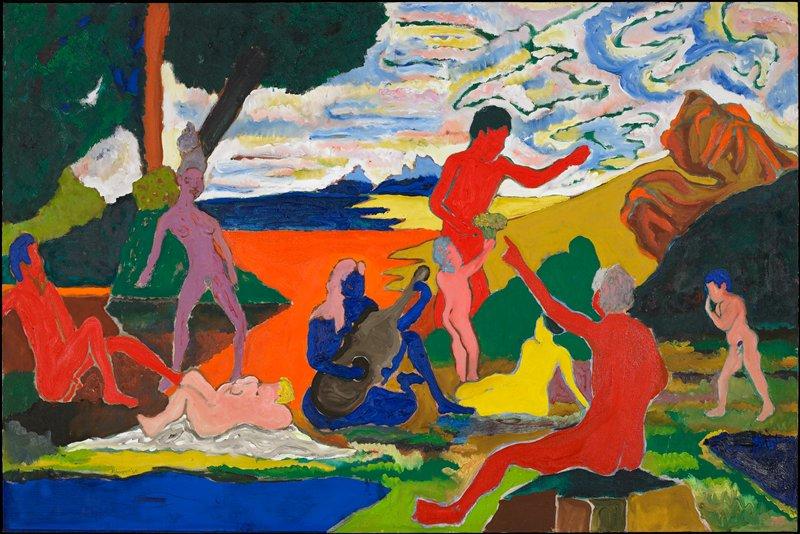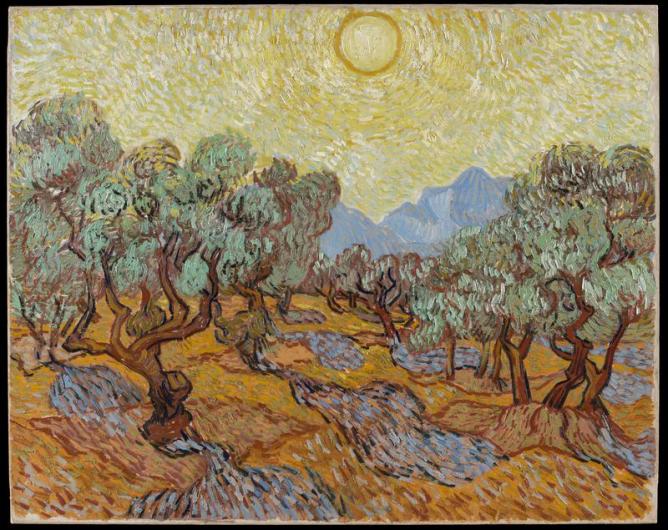
Homage to Nina Simone, 1965, Bob Thompson
Dedicated to inspiring wonder through the power of art, the Minneapolis Institute of Art has over half-a-million visitors each year; general admission is free. One of the largest art museums in the United States, with over 90,000 works from all over the world, MIA’s permanent collection spans thousands of years of world culture and is organized into seven curatorial areas: Arts of Africa & the Americas; Contemporary Art; Decorative Arts, Textiles & Sculpture; Asian Art; Paintings; Photography and New Media; and Prints and Drawings. To help navigate this vast array of stunning artwork– ranging from ancient sculpture to cutting-edge abstraction– MIA curators have come up with this list of 10 must-see pieces.

Owned by the Kii branch of the Tokugawa family– rulers of Japan for almost 250 years– this form-fitting mid-17th century Suit of Armor was designed for protection during close combat. Constructed of iron and lacquered leather scales and plates– covered with gold leaf and laced together with silk thread– the armor is visually stunning. A face mask, forearm sleeves, thigh and shin guards, and bear-fur boots protect the wearer’s entire body. The armor is embellished with protective animals and the crest of the helmet is a golden praying mantis– suggesting the wearer will decimate all enemies.
Image: Red-and-blue-laced Suit of Armor from the Kii Tokugawa Family, mid 17th century, Suit by Unknown Japanese; Artist: Helmet by Saotome Iechika

A crowd favorite, Olive Trees by Vincent van Gogh (1853 - 1890) is currently on loan at the National Gallery in London. One of fifteen canvases that Dutch Post-Impressionist van Gogh created between June and December of 1889, the painting looks out on an olive grove, with blue-gray mountains in the distance. Painted with van Gogh’s trademark vitality, the sunlight seems to dash brightly across the sky as it gilds the beautifully twisted olive trees, while the vibrant orange leaves littering the ground suggest autumn is beginning.
Image: Olive Trees, 1889, Vincent van Gogh

This Ancient Yoruba Shrine head, a terracotta bust, comes from the royal city of Ife in western Nigeria. Dating from the 12th-14th century, this memorial portrait of a woman gazes with serene mystery out at the viewer. Her smooth headdress contrasts with the raised vertical lines across her face– depicting either traditional scarification, or a veil worn by royalty.
Image: Shrine head, 12th-14th century, Ancient Yoruba

A team of monks from the Gyuto Tantric University created this Yamantaka Mandala out of colored sand in 1991. A concentric pattern of geometric shapes used in meditation and initiation rites, a mandala symbolizes the ideal universe. Creating a mandala is believed to benefit all beings. While sand mandalas are usually ephemeral, the MIA preserved this one to honor the 1.2 million Tibetans lost to political-religious persecution during the 20th century.
Image: Yamantaka Mandala, 1991, Monks of the Gyuto Tantric University

This painting by Métis artist Christi Belcourt (1966), It’s a Delicate Balance, depicts a tapestry of beautifully rendered flora and fauna– most of which are currently threatened, endangered, or facing extinction. Belcourt uses her art to honor the interconnectedness of all life and the importance of these creatures in our greater ecosystem. Painted as if Belcourt were beading on hide, these intricate plants, animals, and insects are built up out of dots– drawing on designs and motifs found in traditional Michif beadwork.
Image: It's a Delicate Balance, 2021, Christi Belcourt

This Veiled Lady, sculpted in 1847 by Italian artist Raffaelo Monti (1818–1881), depicts a Vestal Virgin– a priestess of the Roman goddess Vesta– crowned by a flower garland. Monti’s skillfully worked marble mimics the filmy texture of fabric, as her face and neck are obscured by a veil that appears partially translucent.
Image: Veiled Lady, c. 1860, Raffaelo Montiex

Grainstack, Sun in the Mist, by French Impressionist Claude Monet (1840–1926), is one of a series Monet painted investigating the visual effects of time of day, atmosphere, and weather on tall, conical grainstacks. This picture captures an autumnal sunrise. Backlit by the rising sun as it burns off early morning mist, the coolly shadowed grainstack is haloed in bright yellow-orange light.
Image: Grainstack, Sun in the Mist, 1891, Claude Monet

Study for Improvisation V by pioneering Russian abstractionist Wassily Kandinsky (1866–1944) imagines the end of days. Bright swaths of color suggests a fenced field bordered by trees. A tall, red-robed Christ-like figure with streaming yellow hair stands in the foreground, a kneeling figure with a blue veil at its feet, while two horsemen of the Apocalypse jump a fence in the background.
Image: Study for Improvisation V, 1910, Vassily Kandinsky

Known as “the Princess of Polka-dots,” internationally renowned Japanese artist Yayoi Kasuma (1929) creates exuberant, visually layered art. Untitled employs her signature polka dots and “infinity net” motif–interlocking shapes painted with netlike patterns. Untitled is a multifaceted exploration of vibrantly colored, biomorphic shapes.
Image: Untitled, 1967, Kusama Yayoi

Homage to Nina Simone: African-American artist Bob Thompson (1937–1966) painted this tribute to the jazz musician Nina Simone a year before his death. Visually reminiscent of early 20th-century French painter Henri Matisse, a group of dancing and reclining nude figures listen to a guitarist in the middle of a fantastically colored pastoral landscape.
Image: Homage to Nina Simone, 1965, Bob Thompson

Owned by the Kii branch of the Tokugawa family– rulers of Japan for almost 250 years– this form-fitting mid-17th century Suit of Armor was designed for protection during close combat. Constructed of iron and lacquered leather scales and plates– covered with gold leaf and laced together with silk thread– the armor is visually stunning. A face mask, forearm sleeves, thigh and shin guards, and bear-fur boots protect the wearer’s entire body. The armor is embellished with protective animals and the crest of the helmet is a golden praying mantis– suggesting the wearer will decimate all enemies.
Image: Red-and-blue-laced Suit of Armor from the Kii Tokugawa Family, mid 17th century, Suit by Unknown Japanese; Artist: Helmet by Saotome Iechika

A crowd favorite, Olive Trees by Vincent van Gogh (1853 - 1890) is currently on loan at the National Gallery in London. One of fifteen canvases that Dutch Post-Impressionist van Gogh created between June and December of 1889, the painting looks out on an olive grove, with blue-gray mountains in the distance. Painted with van Gogh’s trademark vitality, the sunlight seems to dash brightly across the sky as it gilds the beautifully twisted olive trees, while the vibrant orange leaves littering the ground suggest autumn is beginning.
Image: Olive Trees, 1889, Vincent van Gogh
Megan D Robinson
Megan D Robinson writes for Art & Object and the Iowa Source.























